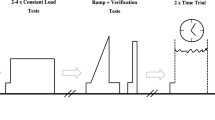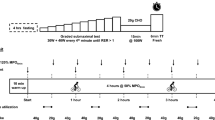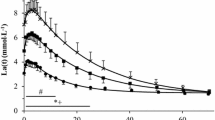Abstract
Training effects on time-to-exhaustion, substrate and blood lactate balances at the maximal lactate steady state velocity (MLSSv) were examined. Eleven male, veteran, long-distance runners performed three tests before and after 6 weeks of training at MLSSv: an incremental test to determine maximum O2 uptake (V̇O2,max) and the velocity at the lactate threshold (vLT), a sub-maximal test of two stages of 20 min at 95 and 105% of vLT separated by 40 min rest to determine the MLSSv and the corresponding lactate concentration (MLSSc) and a time-to-exhaustion run at MLSSv for which the substrate balance was calculated. Duration and distance run at MLSSv increased dramatically respectively from 44±10 to 63±12 min and from 10.4 to 15.7 km respectively (P<0.01). MLSSv increased significantly with training but the relative fraction of V̇O2,max remained the same (85.2±4.5 vs. 85.3±5.2%, P=0.93). MLSSc was unaffected by training as determined from the percentage of energy yielded by carbohydrates (80%) during the exhaustive run at MLSSv. These findings show that training at MLSS elicits small increases in MLSSv and V̇O2,max, but enhances time-to-exhaustion (endurance) at MLSSv substantially (+50%). Training does not change the proportion of carbohydrate oxidized, which is the major substrate used during an exhaustive run at MLSS lasting 1 h.





Similar content being viewed by others
References
Aunola S, Rusko H (1992) Does anaerobic threshold correlate with maximal lactate steady-state? Sports Sci 10:309–323
Beneke R (2003) Maximal lactate steady state concentration (MLSS); experimental and modeling approaches. Eur J Appl Physiol 88:361–369
Beneke R (2003) Methodological aspects of maximal lactate steady state—implications for performance testing. Eur J Appl Physiol 89:95–99
Beneke R, Duvillard SP von (1996) Determination of maximal lactate steady-state response in selected sports events. Med Sci Sports Exerc 28:241–246
Beneke R, Heck H, Schwarz V, Leithauser R (1996) Maximal lactate steady-state during the second decade of age. Med Sci Sports Exerc 28:1474–1478
Beneke R, Hütler M, Leithäuser R (2000) Maximal lactate steady-state independent of performance. Med Sci Sports Exerc 32:1135–1139
Beneke R, Leithäuser R, Hütler M (2001) Dependence of the maximal lactate steady-state on the motor pattern of exercise. Br J Sports Med 35:192–196
Bergman BC, Brooks GA (1999) Respiratory gas-exchange ratio during graded exercise in fed and faster trained and untrained men. J Appl Physiol 86:479–487
Bergman BC, Wolfel EE, Butterfield GE, Lopaschuk GD, Casazza GA, Horning MA, Brooks GA (1999) Active muscle and whole body lactate kinetics after endurance training in men. J Appl Physiol 87:1684–1696
Billat VL, Dalmay F, Antonini MT, Chassain AP (1994) A method for determining the maximal steady state of blood lactate concentration from two levels of submaximal exercise. Eur J Appl Physiol 69:196–202
Billat V, Slawinski J, Bocquet V, Demarle A, Laffite L, Chassaing P, Koralsztein JP (2000) Intermittent runs at the velocity associated with maximal oxygen uptake enable subjects to remain at maximal oxygen uptake for a longer time than intense but submaximal run. Eur J Appl Physiol 81:188–196
Billat VL, Demarle A, Slawinski J, Paiva JM, Koralsztein JP (2001) Physical and training characteristics of top-class marathon runners. Med Sci Sports Exerc 33:2089–2097
Brooks GA, Mercier J (1994) Balance of carbohydrate and lipid utilization during exercise: the “crossover” concept. J Appl Physiol 76:2253–2261
Conley KE, Kemper WF, Crowther GJ (2001) Limits to sustainable muscle performance: interaction between glycolysis and oxidative phosphorylation. J Exp Biol 204:3189–3194
Demarle AP, Heugas AM, Slawinski JJ, Tricot VM, Koralsztein JP, Billat VL (2003) Whichever the initial training status, any increase in velocity at lactate threshold appears as a major factor in improved time to exhaustion at the same severe velocity after training. Arch Physiol Biochem 111:167–176
Donovan CM, Brooks GA (1983) Endurance training affects lactate clearance not lactate production. Am J Physiol 244:E83–E92
Donovan CM, Pagliassoti (1989) Endurance training enhances lactate clearance during hyperlactatemia. Am J Physiol 257:E782–E789
Durnin JV, Womersley J (1974) Body fat assessed from total body density and its estimation from skinfold thickness: measurements on 481 men and women aged from 16 to 72 years. Br J Nutr 32:77–97
Freund H, Oyono-Enguelle S, Heitz A, Marbach J, Ott C, Zouloumian P, Lampert E (1986) Work rate-dependent lactate kinetics after exercise in humans. J Appl Physiol 61:932–939
Friedlander AL, Casazza GA, Horning MA, Huie MJ Brooks GA (1997) Training-induced alterations of glucose flux in men. J Appl Physiol 82:1360–1369
Harnish CR, Swensen TC, Pate RR (2001) Methods for estimating the maximal lactate steady state in trained cyclists. Med Sci Sport Exerc 33:1052–1055
Hawley JA, Palmer GS, Noakes TD (1997) Effects of 3 days of carbohydrate supplementation on muscle glycogen content and utilisation during 1-h cycling performance. Eur J Appl Physiol 75:407–412
Helge JW, Richter EA, Kiens B (1996) Interaction of training and diet on metabolism and endurance during exercise in man. J Physiol (Lond) 492:293–306
Helge JW, Watt PW, Richter EA, Rennie MJ, Kiens B. (2001) Fat utilization during exercise: adaptation to a fat-rich diet increases utilization of plasma fatty acids and very low density lipoprotein-triacylglycerol in humans. J Physiol (Lond) 537:1009–1020
Hoogeveen AR, Hoogsteen J, Schep G (1997) The maximal lactate steady state in elite endurance athletes. Jpn J Physiol 47:481–485
Lajoie C, Laurencelle L, Trudeau F (2000) Physiological responses to cycling for 60 minutes at maximal lactate steady state. Can J Appl Physiol 35:250–261
MacRae HSH, Dennis SC, Bosh AN, Noakes TD (1992) Effect of training on lactate production and removal during progressive exercise in humans. J Appl Physiol 72:1649–1656
MacRae HSH, Noakes TD, Dennis SC (1995) Role of decrease carbohydrate oxidation on slower uses in ventilation with increasing exercise intensity after training. Eur J Appl Physiol 71:523–529
Mader A, Heck H (1986) A theory of the metabolic origin of “anaerobic threshold”. Int J Sports Med 7 (Suppl 1):45–65
Myburgh KH, Viljoen A, Tereblanche S (2001) Plasma lactate concentrations for self-selected maximal effort lasting 1 h. Med Sci Sport Exerc 33:152–156
Pagliassoli MJ, Donovan CM (1990) Role of cell type in net lactate removal by skeletal muscle. Am J Physiol 258:E635–E642
Philipps SM, Green MJ, Tarnopolsky MA, Grant SM (1995) Increased clearance of lactate after short-term training in men. J Appl Physiol 79:1862–1869
Poole DC, Ward SA, Gardner GW, Whipp B (1988) Metabolic and respiratory profile of the upper limit for prolonged exercise in man. Ergonomics 31:1265–1279
Pyne DB, Boston T, Martin DT, Logan A (2000) Evaluation of the Lactate Pro blood lactate analyser. Eur J Appl Physiol 82:112–116
Ruby BC, Coggan AR, Zderic TD (2002) Gender difference in glucose kinetics and substrate oxidation during exercise near the lactate threshold. J Appl Physiol 92:1125–1132
Sahlin K, Tonkonogi M, Söderlund K (1998) Energy supply and muscle fatigue in humans. Acta Physiol Scand 162:261–266
Smith EW, Skelton MS, Kremer DE, Pascoe DD, Gladden LB (1998) Lactate distribution in the blood during steady-state exercise. Med Sci Sport Exerc 30:1424–1429
Stanley WC, Gertz EW, Wisensky DL, Morris DL, Neese RA, Brooks GA (1985) Systemic lactate kinetics during graded exercise in man. Am J Physiol 249:E595–E602
Sumida KD, Urdiales JH, Donovan CM (1993) Enhanced gluconeogenesis from lactate in perfused livers after endurance training. J Appl Physiol 74:782–787
Westgarth C, Hawley TJA, Rickard S, Myburgh KH, Noakes TD, Dennis SC (1997) Metabolic and performance adaptations to interval training in endurance-trained cyclists. Eur J Appl Physiol 75:298–304
Zinker BA, Britz K, Brooks GA (1991) Effects of a 36-hours fast on human endurance and substrate utilization. J Appl Physiol 69:1849–1855
Acknowledgements
This study was supported by grants from the Fondation d’Entreprise Gaz de France.
Author information
Authors and Affiliations
Corresponding author
Rights and permissions
About this article
Cite this article
Billat, V., Sirvent, P., Lepretre, PM. et al. Training effect on performance, substrate balance and blood lactate concentration at maximal lactate steady state in master endurance-runners. Pflugers Arch - Eur J Physiol 447, 875–883 (2004). https://doi.org/10.1007/s00424-003-1215-8
Received:
Revised:
Accepted:
Published:
Issue Date:
DOI: https://doi.org/10.1007/s00424-003-1215-8




